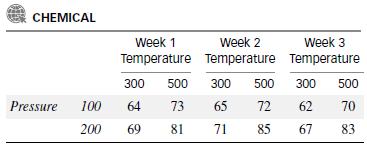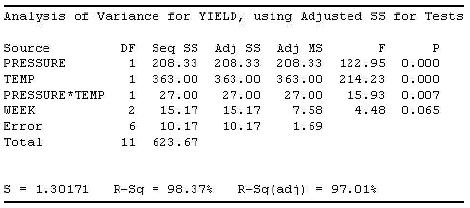A 2 2 factorial experiment was conducted for each of 3 weeks to determine the effect
Question:
A 2 × 2 factorial experiment was conducted for each of 3 weeks to determine the effect of two factors, temperature and pressure, on the yield of a chemical. Temperature was set at 300° and 500°. The pressure maintained in the reactor was set at 100 and 200 pounds per square inch. Four days were randomly selected within each week, and the four factor-level combinations were randomly assigned to them. The yield data for the 2 × 2 factorial experiment, laid out in three blocks of time, are shown in the accompanying table. The MINITAB printout for the analysis of variance is shown above.

a. What type of design was used for this experiment?
b. Construct an analysis of variance table showing all sources and their respective degrees of freedom.
c. Why does the analysis of variance table not include sources for the interaction of weeks with temperature and pressure?
d. Do the data provide sufficient evidence to indicate an interaction between temperature and pressure? Give the p-value for the test. What is the practical significance of this result?
e. Was blocking in time useful in increasing the amount of information in the experiment? That is, do the data provide sufficient evidence to indicate differences among the block means? Give the p-value for the test.

Step by Step Answer:

Statistics For Engineering And The Sciences
ISBN: 9781498728850
6th Edition
Authors: William M. Mendenhall, Terry L. Sincich





